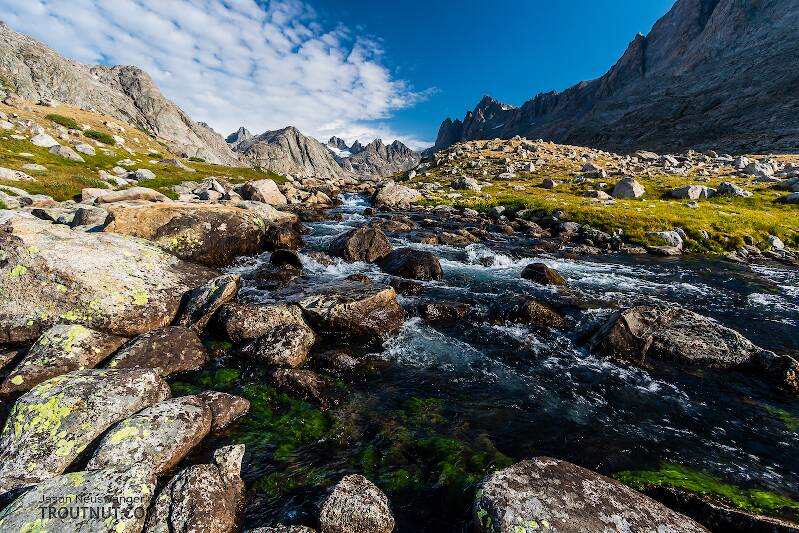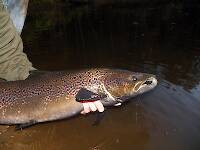
Blue-winged Olives
Baetis
Tiny Baetis mayflies are perhaps the most commonly encountered and imitated by anglers on all American trout streams due to their great abundance, widespread distribution, and trout-friendly emergence habits.
Featured on the forum

This is an interesting one. Following the keys in Merritt R.W., Cummins, K.W., and Berg, M.B. (2019) and Jacobus et al. (2014), it keys clearly to Ephemerella. Jacobus et al provide a key to species, but some of the characteristics are tricky to interpret without illustrations. If I didn't make any mistakes, this one keys to Ephemerella mucronata, which has not previously been reported any closer to here than Montana and Alberta. The main character seems to fit well: "Abdominal terga with prominent, paired, subparallel, spiculate ridges." Several illustrations or descriptions of this holarctic species from the US and Europe seem to match, including the body length, tarsal claws and denticles, labial palp, and gill shapes. These sources include including Richard Allen's original description of this species in North America under the now-defunct name E. moffatae in Allen RK (1977) and the figures in this description of the species in Italy.

Troutnut is a project started in 2003 by salmonid ecologist Jason "Troutnut" Neuswanger to help anglers and
fly tyers unabashedly embrace the entomological side of the sport. Learn more about Troutnut or
support the project for an enhanced experience here.
Al514 on May 1, 2007May 1st, 2007, 9:59 am EDT
Does anyone have any advice for fishing new water? I am only a year into fly fishing and I tend to get a bit nervous on unfamiliar water and also a bit doubtful that I will catch anything.
CaseyP on May 1, 2007May 1st, 2007, 2:26 pm EDT
a very wise person once told me, "You have to go somewhere to know how to go there."
so just do it. when you don't know the stream, wear your highest waders unless it's hot enough to wet wade. use a wading stick.
if you're on your own (good for you!) the trout will let you know how you're doing. no other opinion matters. most of what you have learned about one stream will translate to others, except perhaps for the hatch information, and the local fly shop can help you there. most of them really enjoy giving advice. and then there are the various fly-fishing fora...
you might have to be prepared to not catch anything; it's frustrating and painful, but you are not the lesser because of it. my best fishing buddy, when he gets skunked, reminds me that he goes "for the total experience." yep, he's a saint. i try to be like him.
so just do it. when you don't know the stream, wear your highest waders unless it's hot enough to wet wade. use a wading stick.
if you're on your own (good for you!) the trout will let you know how you're doing. no other opinion matters. most of what you have learned about one stream will translate to others, except perhaps for the hatch information, and the local fly shop can help you there. most of them really enjoy giving advice. and then there are the various fly-fishing fora...
you might have to be prepared to not catch anything; it's frustrating and painful, but you are not the lesser because of it. my best fishing buddy, when he gets skunked, reminds me that he goes "for the total experience." yep, he's a saint. i try to be like him.
"You can observe a lot by watching." Yogi Berra
Shawnny3 on May 2, 2007May 2nd, 2007, 12:00 am EDT
What great advice, Casey.
I would add that it may be an even more rewarding experience if you don't stop by the local flyshop first. When you go to a new place without any foreknowledge, you are relying on your ability to read insect activity and feeding behavior, the quality and versatility of your flies, and the quality of your presentation. Yes, when you do this you ought always to brace yourself for failure, but the risk of failure only makes your successes that much sweeter.
I think there's a dose of the adventurous in all flyfishermen - otherwise we'd all just be plunking worms. Sometimes we get lazy, though, and rely so much on what others have done before us that we don't bother to rise to the challenge ourselves. The more of your own energy and creativity you put into it, the better the flyfishing experience. So my advice is the same as Casey's: Go out there and have fun trying to figure out whatever puzzle confronts you when you get there.
-Shawn
I would add that it may be an even more rewarding experience if you don't stop by the local flyshop first. When you go to a new place without any foreknowledge, you are relying on your ability to read insect activity and feeding behavior, the quality and versatility of your flies, and the quality of your presentation. Yes, when you do this you ought always to brace yourself for failure, but the risk of failure only makes your successes that much sweeter.
I think there's a dose of the adventurous in all flyfishermen - otherwise we'd all just be plunking worms. Sometimes we get lazy, though, and rely so much on what others have done before us that we don't bother to rise to the challenge ourselves. The more of your own energy and creativity you put into it, the better the flyfishing experience. So my advice is the same as Casey's: Go out there and have fun trying to figure out whatever puzzle confronts you when you get there.
-Shawn
Jewelry-Quality Artistic Salmon Flies, by Shawn Davis
www.davisflydesigns.com
www.davisflydesigns.com
Troutnut on May 2, 2007May 2nd, 2007, 3:58 am EDT
I've got to kind of disagree with Shawn. One of the reasons I like fly fishing so much is that you can often take the "are the fish here?" variable out of the question and you're still left with lots of other challenges. I don't like fishing somewhere and wondering if there's a fish of the right species within 100 yards of my fly. I like the challenge of catching the fish, and of figuring out where they're holding in a stream section where I know they're present. I don't like the crapshoot element of wondering which streams or stream sections have a decent population in the first place.
Usually, the longer I've been in an area, the more likely I am to explore water that may not pan out. But when I'm starting out somewhere new, I like to try the most promising places first. Fly shops are good for advice, and most states also have a few fishing guidebooks that can point you to some productive streams in an area.
As for fishing rather than finding new water... I usually approach it the same way as anywhere else, trying to read the signs on the surface. I probably move a little faster and don't try any one spot quite as hard on new water.
Usually, the longer I've been in an area, the more likely I am to explore water that may not pan out. But when I'm starting out somewhere new, I like to try the most promising places first. Fly shops are good for advice, and most states also have a few fishing guidebooks that can point you to some productive streams in an area.
As for fishing rather than finding new water... I usually approach it the same way as anywhere else, trying to read the signs on the surface. I probably move a little faster and don't try any one spot quite as hard on new water.
Jason Neuswanger, Ph.D.
Troutnut and salmonid ecologist
Troutnut and salmonid ecologist
CaseyP on May 2, 2007May 2nd, 2007, 6:42 am EDT
One of the reasons I like fly fishing so much is that you can often take the "are the fish here?" variable out of the question and you're still left with lots of other challenges.
Amen, Jason! knowing the fish are there is why i fish with flies instead of bait--makes the game last longer and gives Mr. Picky Q. Brown a chance.
"You can observe a lot by watching." Yogi Berra
TheMidge on May 2, 2007May 2nd, 2007, 7:18 am EDT
I haven't been fly fishing much longer than yourself, and I suggest doing at least a little research on the water you are going to fish. It's not fair to the fish for you to be caught under-equipt. When I fish new water, Unless there's a hatch going on, I tend to stick to the old reliables, wooly buggers, pheasent tails, things like that. I've been on a small stream with my 3 wt on caught anything from a landlocked atlantic running up out of a large lake to a 6 lb smallmouth. Also, a little research can keep you from getting too lost. I will say this, though. There are few things more rewarding than catching a fish on strange water, by yourself, with a fly that you tied. It kind of gives the feeling like, despite the obstacles, you did everything right, on your own. Just my two cents
Al514 on May 2, 2007May 2nd, 2007, 10:07 am EDT
Thanks guys. You all have been very helpful. Everything said makes sense, and I appreciate everyone sharing their thoughts. Being a beginner, I believe I tend to complicate any fly fishing situation into a puzzle I get myself lost in.
Casey P - The "total experience" is what I believe I have been missing whenever I have been out on the water. Usually my main focus is to catch a fish, and when I don't I became very frustrated. I will have to keep reminding myself of this "total experience" thing.
Thanks again fellas, tight lines.
Casey P - The "total experience" is what I believe I have been missing whenever I have been out on the water. Usually my main focus is to catch a fish, and when I don't I became very frustrated. I will have to keep reminding myself of this "total experience" thing.
Thanks again fellas, tight lines.
Shawnny3 on May 2, 2007May 2nd, 2007, 12:04 pm EDT
You guys are probably right hat my advice isn't that good, especially for a beginner. Success breeds success, and if that means getting some ideas about the water before heading out to it for the first time, then that's probably the best route. I'll stand by my statement, though, that the more of your own energy and creativity you put into it, the better the flyfishing experience.
I thought TheMidge's post was especially insightful - with you on everything you said.
-Shawn
I thought TheMidge's post was especially insightful - with you on everything you said.
-Shawn
Jewelry-Quality Artistic Salmon Flies, by Shawn Davis
www.davisflydesigns.com
www.davisflydesigns.com
Softhackle on May 3, 2007May 3rd, 2007, 12:50 am EDT
Central NY,
Might I suggest a book you might find at your local library called Tactics On Trout by Ray Ovington. It may also be found at used book stores, online. It discusses reading the water, and how to fish certain situations. While each waterway is different, it does help one "see" what they need to see to fish a new place successfully.
I agree with some of the posts here. You must be cautious fishing unknown water. Take it slow and wade carefully if you wade. As far as fishing-- You must read the water, and explore it. You must watch, sometimes wait, think and be sensitive to what's going on in front of you. "Learning" new water is not something that happens overnight. There is much to be digested. Most importantly-be careful and have fun.
Mark
Might I suggest a book you might find at your local library called Tactics On Trout by Ray Ovington. It may also be found at used book stores, online. It discusses reading the water, and how to fish certain situations. While each waterway is different, it does help one "see" what they need to see to fish a new place successfully.
I agree with some of the posts here. You must be cautious fishing unknown water. Take it slow and wade carefully if you wade. As far as fishing-- You must read the water, and explore it. You must watch, sometimes wait, think and be sensitive to what's going on in front of you. "Learning" new water is not something that happens overnight. There is much to be digested. Most importantly-be careful and have fun.
Mark
"I have the highest respect for the skilled wet-fly fisherman, as he has mastered an art of very great difficulty." Edward R. Hewitt
Flymphs, Soft-hackles and Spiders: http://www.troutnut.com/libstudio/FS&S/index.html
Flymphs, Soft-hackles and Spiders: http://www.troutnut.com/libstudio/FS&S/index.html
Obtuseangle
Posts: 6
Posts: 6
Obtuseangle on May 3, 2007May 3rd, 2007, 10:14 am EDT
Central New York,
I'm fortunate enough to be able to travel during the summer. Even so, I may have only a few days on new water and don't have time to explore. The internet gives a wealth of information on fishing conditions you will find on many streams. A couple years ago I was going to the Taos area and learned on the Internet that, due to rain, all but one higher altitude stream was chocolate milk. Knowing that before hand saved me a lot of time and frustration. Also, the local fly shop will always give you detailed directions to the water. I've even e-mailed a shop and asked about current conditions. Never had a bad experience with the guys who work fly shops.
I treat fly fishing like casting practice. When I catch anything I am pleasantly surprised. When I don't I still had fun splashing in the water. Every once in a while it comes together for a moment.
I'm fortunate enough to be able to travel during the summer. Even so, I may have only a few days on new water and don't have time to explore. The internet gives a wealth of information on fishing conditions you will find on many streams. A couple years ago I was going to the Taos area and learned on the Internet that, due to rain, all but one higher altitude stream was chocolate milk. Knowing that before hand saved me a lot of time and frustration. Also, the local fly shop will always give you detailed directions to the water. I've even e-mailed a shop and asked about current conditions. Never had a bad experience with the guys who work fly shops.
I treat fly fishing like casting practice. When I catch anything I am pleasantly surprised. When I don't I still had fun splashing in the water. Every once in a while it comes together for a moment.
Rivergeezer
Posts: 1
Posts: 1
Rivergeezer on May 20, 2007May 20th, 2007, 2:05 am EDT
The first thing I do when approaching new water is to sit quietly at the edge of the stream to see what's going on. Any action on top? Then look to see what they're hitting and put the closest fly you've got that matches the real thing.
If I see no action on top, I turn over some rocks to see what is attached to the underside. Good chance this is what the trout are eating, so I rig for nymph fishing.
If you don't wish to do either of the above and just start tossing stuff into the water, try a large dry (12 or 14) and attach a smaller X tippet to the hook with a favorite nymph. The length of the dropper nymph tippet will depend on the depth of the water you're fishing.
Most importantly, enjoy being where you are.
If I see no action on top, I turn over some rocks to see what is attached to the underside. Good chance this is what the trout are eating, so I rig for nymph fishing.
If you don't wish to do either of the above and just start tossing stuff into the water, try a large dry (12 or 14) and attach a smaller X tippet to the hook with a favorite nymph. The length of the dropper nymph tippet will depend on the depth of the water you're fishing.
Most importantly, enjoy being where you are.
Blest be the trout fisher, for the Lord doth loveth him more.
3:14, Book of Geezer
3:14, Book of Geezer
Quick Reply
Related Discussions
Topic
Replies
Last Reply
1
Apr 27, 2009
by Martinlf
by Martinlf
1
Sep 14, 2010
by SlateDrake9
by SlateDrake9







